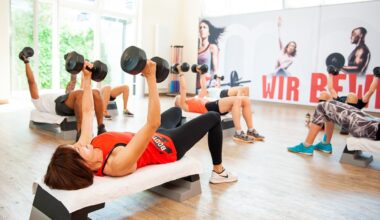Integrating Mobility Drills to Complement Running Flexibility
Running is an activity that requires not just endurance but also a high degree of flexibility. By integrating mobility drills into your running routine, you can significantly enhance your running performance. Mobility drills not only improve flexibility in key muscle groups but also help in preventing injuries. These drills encompass dynamic stretches that activate the core, hips, and legs. Important mobility drills include hip circles, leg swings, and dynamic lunges that prepare the muscles for the strain of running. Additionally, performing adequate warm-up exercises boosts blood circulation, ensuring that muscles are ready for the action. As you become more flexible, you may notice improved stride length, stability, and speed. Furthermore, mobility drills can optimize your range of motion, allowing for more efficient running form. Ultimately, the incorporation of mobility drills into your routine will not only elevate your performance but also contribute to a more pleasurable experience while running. Make sure to dedicate a portion of your workout time to these essential exercises to reap the full benefits of flexibility in your running routine.
Many runners experience tightness after long runs, which could lead to discomfort and subsequent injuries. Mobility drills specifically target tight muscle areas to help alleviate these issues. Incorporating exercises like frog stretches or pigeon poses can improve hip flexor and glute flexibility. By focusing on key muscle groups that are often neglected, you ensure a balanced development of your body. Besides, improving muscle elasticity can enhance your overall performance, leading to a more efficient motion. Performing post-run mobility drills can also facilitate quicker recovery, allowing you to return to training sooner. The aim is not only to stretch but also to improve the overall form and mechanics of your running. Tailor your mobility routine according to your specific needs and body mechanics. Experiment with various drills, like banded hip openers or standing quadricep stretch, to find what works best for you. Remember to listen to your body, gradually increasing intensity and duration in each mobility drill. By doing so, you enable your body to adapt effectively to the demands of running.
Understanding Mobility and Flexibility
The concepts of mobility and flexibility, while similar, serve different purposes in running. Flexibility refers to the passive range of motion in your joints and muscles, while mobility indicates your ability to actively control that range. Therefore, when running, mobility dictates how well you can perform dynamic movements effectively without sacrificing form. This distinction is crucial as many injuries stem from a lack of mobility rather than flexibility. It’s possible to be flexible yet still limited in your ability to utilize that flexibility while running. Hence, it is vital that runners engage in drills that challenge and improve their mobility. Targeting areas like the hips, core, and upper body allows for more fluid running mechanics. Starting with basic movements, like cat-cow stretches and spine rotations, establishes a solid foundation that can be built upon. As your mobility improves, further integrate more challenging drills that require higher levels of coordination and strength, such as single-leg deadlifts or lateral lunges. Understanding these differences will aid in tailoring your training for better running outcomes.
Incorporating mobility drills should be seamless and fluid within your running schedule. One recommended approach is integrating these drills as part of your warm-up routine. Begin with light jogging or brisk walking to increase heart rate, followed by dynamic stretches that engage the entire body. Usage of resistance bands can also enhance these drills, providing support and extra challenge. They promote not only strength but also flexibility in key running muscles. Research suggests that doing mobility drills consistently leads to improved performance, as well as a decrease in injury prevalence, over time. By blending mobility workouts with your regular training sessions, you can enhance your physical capabilities while enjoying the mental benefits of running. Whether with small group sessions or solo workouts, maintain a focus on correct form as you execute your drills. As you advance, alter the intentions of your drills, aiming for greater endurance, speed, or stability. This variation keeps your routine engaging while ensuring all areas are addressed. Therefore, consider your approach to mobility drills as a vital aspect within the broader context of your running training.
Potential Mistakes to Avoid
While mobility drills are advantageous, several common mistakes often derail their effectiveness. One prevalent mistake is rushing through the exercises without maintaining proper form. Quality trumps quantity, and spending more time in each position ensures effective stretching and relaxation of muscle fibers. It’s essential to focus on the breath during each drill, and recognize when a specific stretch feels beneficial or troublesome. Additionally, neglecting to target the areas where you feel tightness can limit the efficacy of these drills. Rather than adopting a one-size-fits-all approach, be observant of your body’s feedback. Commencing your mobility routine without adequate warm-up can also lead to injury, as cold muscles are less pliable. Start modestly, gradually intensifying the stretches. Consistency is key; practicing drills only sporadically diminishes the ability to see significant results over time. Lastly, many overlook the importance of cooldown stretches post-run, which are essential for recovery. By being mindful of these potential missteps, runners can fully harness the benefits that mobility drills offer to enhance their running abilities.
As you delve into mobility drills, focus on building a regimen that encompasses various exercises to challenge your body effectively. Adding stability training that utilizes balance boards or wobble cushions can also strengthen your core, which can indirectly affect your running agility. Incorporating mobility routines into your schedule makes your training holistic and well-balanced. With these tailored mobility drills, you create an effective blend of strength, flexibility, and functionality. Additionally, document your progress by taking notes on how you feel before and after these routines. This insight can help tailor your future workouts more effectively. Try to remain patient, as improving flexibility and mobility takes time. Celebrate small improvements, be it increased motion or reduced tightness. Supportive running groups or partners can enhance commitment levels and provide external motivation for long-term improvement. Modern technology can also offer various resources like mobile applications to guide exercises. Remember to enjoy the process and make it a fun and rewarding part of your overall fitness journey. This mindset will help maintain motivation and promote long-term adherence to a running program.
Conclusion on Mobility Integration
Integrating mobility drills is a gradual process requiring commitment and dedication. By understanding the significance of mobility, you can elevate your running routine dramatically. These drills not only improve performance but also enrich your overall experience by minimizing risk and discomfort. Set realistic goals for introducing mobility routines into your training, ensuring you’re making necessary adjustments suited to your level. A comprehensive approach encompassing both flexibility and active mobility will grant you brand new insights into your physical capabilities. Over time, you may discover preferences for certain exercises that resonate with your body and yield favorable results. Finally, join jogging or running clubs that emphasize the importance of mobility, boosting camaraderie and accountability. Therefore, commit to consistency, exploring various mobility drills to craft a personalized routine. Engaging with the community through workshops or online video demonstrations will also enrich your practice. Remember, flexibility and mobility are essential tools not just for running but for overall wellness and health. Let mobility drills complement your running journey, providing rewards that are both immediate and long-term.


